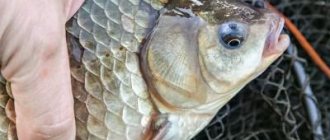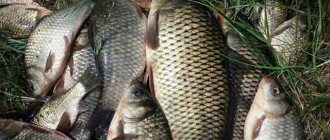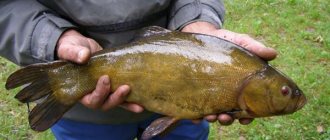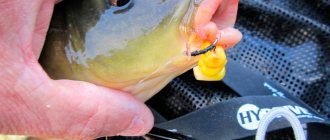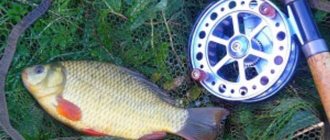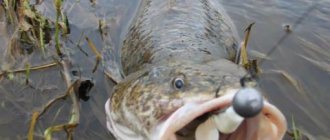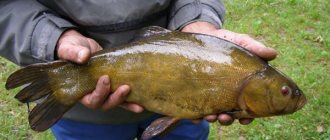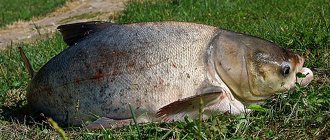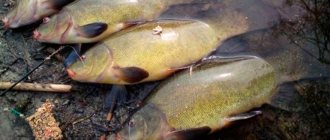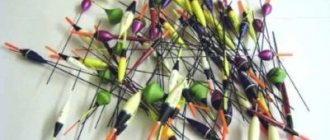Baits for catching crucian carp of animal origin: types, features, when to use
First, let's look at what types of animal bait for crucian carp are common:
- Worm. Timeless classic. It’s hard to imagine any float fishing without this bait. However, the earthworm has a fellow animal - the dung worm, which is “more successful” than its neighbor. This bait is suitable for beginners, since the worm is common; if you wish, it will not be a problem to dig the worm yourself from the shore or buy it at a fishing store. Can be used at any time of day or month of the fishing season.
- Maggot. Another of the three hits of float fishing. More suitable for smaller specimens, but has one huge advantage - “survival on the hook” , unlike a worm and bloodworms, maggots hold on quite tightly and can serve for a long time, which is especially useful when catching fast fish and will make life easier for beginners, since they often In them, fitting a new bait can be a problem. If you live far from the city and getting maggots is problematic, you can use the following advice. Take a piece of meat or fish. In the case of fish, you will need to remove the scales. Place them so that they do not disturb neighbors and are difficult to reach for cats and dogs. Make small cuts in them and leave for 3-5 days. After the specified period, you will receive ready-made maggots.
- Bloodworm. There are many anglers who believe that crucian carp should be caught only with bloodworms . There is a reason for this, since often this fish bites only on it. It is best to plant a large bloodworm over the head, this way it will remain viable longer. If it is small, then you can use the “sandwich” attachment method, which will be described below.
Important! Crucian carp is an extremely cautious fish. The bite takes a long time, at first the fish seems to suck the bait, which is a disadvantage when fishing with bloodworms, because it can happen that the crucian carp sucks out all the nutrition from the bloodworm, and you, perplexed, will get a transparent body. For the same reasons, when biting, it is worth hooking more sharply so that the crucian carp gets on the hook.
- Live bait. If you want to catch the approval of fellow hobbyists or break an old record, use it. The top fishing rod is best suited for fishing for crucian carp with live bait. Despite its size, it has a number of advantages: vitality and the same habitat as crucian carp. If you don’t have a top-smelting fish, you can also use small-sized crucian carp itself. Live bait fishing is best done in the spring and/or at night as this is a time when water temperatures are low and big crucian carp move higher up where topwaters make up the main diet of the big fish.
How to hook?
Thanks to its thick skin, the maggot is easily placed on the hook and stays on it for a long time. But this property of the bait can also be attributed to its disadvantages, since when biting, the fish may not be hooked, and accordingly the tackle will remain empty. Therefore, it is advisable to put the maggot on the hook along its entire length. But fishermen also use several other options:
When the bite is sluggish (and this means often), it is desirable that the maggot remains alive, and even retains its agility. This provokes fish better than a motionless dead larva. But the maggot can retain its vitality provided that its insides are not damaged by the hook. Therefore, the classic recommendation for baiting a maggot looks like this: - use the tip of a hook to pry the skin near the head between the so-called “eyes”, then bring the sting out under the skin and move the maggot towards the forearm.
Even experienced fishermen do not know exactly how best to place a bloodworm or maggot on a hook, so that on the next cast the fish will finally stop resting and start catching.
The question “how to best place bait on a hook” is one of thousands among experienced fishermen, in the context of their constant search for secret techniques for successful fishing. And for beginner fishing enthusiasts, this question is direct and essential - really, how to properly attach a bloodworm or maggot to a hook?
Place the bloodworm on the hook
The usual recommendations for planting bloodworms are as follows.
- Only extremely thin “crank” hooks are used. You shouldn’t even try to pull a moth onto a “carpokiller” hook.
- Bloodworms are selected before baiting. The largest larvae with the most pronounced fighting qualities are used. It bites much better on a moving larva.
- We replace the bloodworm on the hook with a fresh one in time. Then you can get the most from the reservoir.
Hanging
One bloodworm is taken with the fingers of one hand (be careful not to crush it). The hook is taken with the other hand. The bloodworm is then pierced with a sting approximately between 3 and 4 segments from its head. The hook is removed from the larva near the head itself, and it moves to the bend of the hook. That's all - the living creatures do not lose their vitality for a long time (about 15 minutes) and remain attractive to fish.
According to some anglers, the attractiveness of the bait will increase if a pair or three larvae are attached to the hook in a similar way. This is especially true when it comes to catching heavy fish.
A bloodworm hanging from a hook is good when the fish is moderately active and will greedily grab it, swallowing it along with the hook. But this rarely happens. Much more often, the fish carefully takes the mosquito larva by the tail and pulls it off the hook, leaving the angler with only empty hooks over and over again.
Stocking
With the weak, the method of baiting bloodworms with a “stocking” helps. It's easy to do. In the same way, the larva is pierced near the head, only this time the sting is directed towards its tail. With careful movements of the fingers, it is pulled onto the hook. Tail droop is minimized as much as possible, but the hook is not removed from the body. Now the fish has nothing special to pull off the larva, and it captures it immediately along with the hook.
Tips for fisherman: How to catch crucian carp in the spring with a float rod - Features of choice
Accidentally hitting
Everything is not bad, but such actions require a lot of time and sleight of hand. But what to do in a situation when the fish is really hungry and every second counts? Or when in the cold your fingers are hard to control? Or in a situation where your hands are shaking and you can’t even see one bloodworm? Then the method of attaching a bloodworm to the rescue comes to the rescue.
The bloodworm ball is grabbed with two fingers. Then, the hook is pierced several times through the entire ball, and within a second, one or several bloodworms or parts of them are somehow picked up on it. And such a bait is sent into the water (under the ice), and with a passionate bite, the fish are caught no worse than if the fisherman very diligently put on the bloodworm for several minutes and examined the results of his work.
Big bunch - big catch
To catch large fish, anglers sometimes use a whole bunch of bloodworms tied to a hook. For example, this is often done when fishing for bream. A small piece of nipple elastic will help secure the bunch of bloodworms to the hook. When fishing, the entire bunch is planted in seconds - just insert the sting into the nipple, which already contains several bloodworms. And the thickness of the hook now does not play any role, which is a big plus for catching large fish.
But how to thread a bloodworm into a nipple, and even a whole bunch?
How to thread a bloodworm through an elastic band
The simplest device that every angler can make with his own hands will help. Take a plastic handle and throw out all the guts. The body is cut with a knife “on an oblique”, so that at its cut end something in the form of a scoop with a pointed nose is formed. Then a short piece of elastic is pulled onto this body through its sharp part. Several bloodworms are placed on the scoop, and the nipple is pulled off the handle, simultaneously capturing all the bloodworms located “in the scoop.”
Having spent half an hour at home preparing the bunches and n-number of elastic bands, the fisherman will come to the pond, as they say, fully armed. By the way, the nipple, after the bloodworm is eaten by the fish, can be used for the second pass.
If bloodworms can be planted in any way you like - “as it turns out” or as your imagination dictates, and at the same time, not without reason to count on a bite, then with maggots the situation is somewhat more complicated. One circumstance adds special features to its use - this larva has a very hard and durable skin.
Live maggot
When the bite is sluggish (and this means often), it is desirable that the maggot remains alive, and even retains its agility. This provokes fish better than a motionless dead larva. But the maggot can retain its vitality provided that its insides are not damaged by the hook. Therefore, the classic recommendation for baiting a maggot looks like this: - use the tip of a hook to pry the skin near the head between the so-called “eyes”, then bring the sting out under the skin and move the maggot towards the forearm.
This way you can plant several maggots to catch large fish. After biting (catching a fish), it often happens that the maggot on the hook remains intact, alive and fidgety, and is suitable for re-casting.
Baiting options
A maggot can very easily take revenge on a fisherman for being hooked to be eaten by fish. It wraps itself around the hook and simply covers the sting with its body. Further: - the fish bites, the float quickly moves away to the side with a dive, the fisherman even waits to spot the carp (whale) for sure, aaaand... and on the hook there is only a smiling maggot.
If the larva covers the sting with its hard skin, then it will not be possible to hook the fish. Therefore, when the bite is confident, fishermen bait the maggot with a stocking, after which it quickly dies. Or, many fishermen recommend doing a combination of baiting techniques - a couple of larvae are put under the skin to keep them alive, and then a maggot pierced through its length is placed near the sting.
Whenever baited, the hook tip is always removed from the body of the blowfly larva, and remains free for hooking fish.
How to make larvae immobile
Sometimes, for conditions of confident biting on bait, or when there is not enough time at competitions, anglers specially use killed larvae so that they do not interfere with the bait with their fidgetiness and do not make idle hooks. Maggots are killed with heat. In order not to cook it over a fire, the larvae are first cooled (spring water), then immediately placed in hot water (tea from a thermos). After this procedure, the fisherman confidently throws maggots on a hook towards the ever-hungry mouth of the long-awaited carp.
Catching crucian carp with a worm
How to prepare worms for crucian fishing
If you want to achieve great results, carry out preliminary preparation of the worm before fishing.
It would be a good idea to at least moisturize the worm so that it does not lose its activity during fishing; you can also add birch sawdust or grass to the bait storage container a few hours before fishing to remove unpleasant odors.
Methods of “preserving” the worm in flavorings are also possible. To do this, you need to use a plastic container in which you need to place a cotton rag soaked in additives. It is good to add anise oil and vanilla to the worm. Place the herbs on top of the rag and the worms themselves and add a little water, then leave the entire container for 12 hours in a cool place and away from sunlight.
On a note! When fishing, there are times when none of the common methods work, so try one trick. When crucian carp behaves capriciously, coat the worm in Garlic flavoring. There have been cases where this supplement has produced impressive results. Be careful when adding flavorings to your bait. Crucian carp is sensitive to them, and if carelessly they are easily frightened by too strong a smell, which will spoil the bite.
How to properly attach a worm to a hook
There are several ways to mount a worm, let's look at a few of them.
- Planting a worm with a “stocking” . With this method, the bait is put along, through the center of one of the ends of the worm. As a result, it seems to envelop the entire hook, forming a stocking. At the end, it is recommended to expose the tip of the hook for a better bite.
- Placing worms in a bunch . In this method, several worms are taken and pierced through the core, ultimately creating a bunch of several worms that looks attractive to the fish.
- In pieces. In this case, you tear the worm into small pieces by threading it onto the hook through the core. The secret of this method is that they spread a smell in the water that actively attracts fish.
- Puncture in three places . For this method, a large specimen is taken, in which three punctures are made: at one end, in the middle and at the other end. The advantages of this method are that the worm exhibits maximum mobility, attracting the desired trophy.
How to properly put a worm on a hook. Basic methods.
Both experienced fishermen and beginners are undoubtedly interested in how to properly place a worm on a hook. At first glance, this is a trivial question. But in reality, this largely determines how successful the fishing will be overall.
As you know, worms and maggots are the best baits. Any type of fish bites well on them. The only exception is very hot days, when fish prefer bait of plant origin. However, in such a case, many fishermen resort to a little trick, making a kind of sandwich with a worm.
It is extremely important for any fisherman to be able to bait a worm correctly. Naturally, you can string it at random and try to catch it. But we do not recommend fishing “at random”. Even in something as simple at first glance as fishing, some skills are needed. In addition, not every fish can hook onto an incorrectly mounted worm. In most cases, she will be able to simply pull it off the hook or simply bite it off without being hooked. It's all due to an incorrectly placed worm!
As you know, worms and maggots are the best baits. Any type of fish bites well on them. The only exception is very hot days, when fish prefer bait of plant origin. However, in such a case, many fishermen resort to a little trick, making a kind of sandwich with a worm.
Nozzle methods
There are several ways to attach a worm to a hook, but you should use some recommendations:
- When placing a worm on a hook, it should remain mobile, which means that when placing it, it should not be seriously injured.
- As a rule, the hook is selected depending on the size of the fish that can be caught, and the size of the bait depends on the size of the hook.
If a dung worm is available, usually not large in size, then it is planted entirely, using several options. It can be planted by piercing it somewhere in the middle once or twice, planted in a ring, or hooked onto the end of the worm. Here, the size of the worm itself, as well as the fish specimens, is decisive. If you are catching roach, then a small worm is suitable for it, which is placed on the hook in a single copy. If you are in the mood for larger fish, such as bream or large crucian carp, then you can put several small worms on the hook, forming a kind of bunch of worms on the hook, which will effectively attract large fish.
If the worm is very large, then it can be torn into several pieces and placed on the hook in separate parts. But this method is not very effective when the fish takes the bait weakly, especially since there is an inactive part of the worm on the hook.
You can use another option, which involves placing another bait, such as corn or pearl barley, on the hook along with the worm.
Fishermen call such combinations “ sandwiches ”.
Most of all, perch loves the worm, but peaceful fish such as roach, bream, rudd, crucian carp, etc. do not refuse it. It is used when fishing with a float rod, as well as with bottom gear, such as a feeder.
If the worm is very large, then it can be torn into several pieces and placed on the hook in separate parts. But this method is not very effective when the fish takes the bait weakly, especially since there is an inactive part of the worm on the hook.
Stocking - a method for cunning fish
When the above-described methods of attaching a worm give too many empty bites (the fish eats the bait, grabs the worm by the tip), the method of baiting with a stocking is used. The whole worm or part of it is threaded so that the hook is almost completely closed. The fish has almost no chance of tearing off the worm with impunity without swallowing it completely.
When the above-described methods of attaching a worm give too many empty bites (the fish eats the bait, grabs the worm by the tip), the method of baiting with a stocking is used. The whole worm or part of it is threaded so that the hook is almost completely closed. The fish has almost no chance of tearing off the worm with impunity without swallowing it completely.
Methods for attaching a worm
Let's look at the most popular options for forming a nozzle:
- "Stocking" . The body is pierced almost from the head and put on a hook like a stocking. In this case, part of the bait hangs from the sting, hidden inside or brought out, and actively moves, attracting fish. This is the most common and versatile option.
- Entering the fishing line . In essence, this is a variation of the previous method: the algorithm is the same, but the worm is pulled higher onto the fishing line through the fore-end. In this case, it is important that the hook is attached to the fishing line through a spatula, and not a loop or eye, especially when it comes to delicate nereis. A thick-skinned prospector can also be pulled through a loop.
- "Ring" . We make a through puncture of the individual near the head and insert the sting closer to the tail, without bringing it out (“the tail” remains free and writhing).
- "Eight" . We have before us a peculiar evolution of the figure eight: the first puncture, as in the previous case, the second - in the middle of the body and also through, the third - at the tail without bringing the fore-end out.
- "Half" . Only half of the worm is placed on the hook: the sting is inserted into the gap. This method is used for catching small fish with miniature hooks.
- "Dotted line" . The body is, as it were, pierced with a sting in several places sequentially. This attachment is suitable for “thick-skinned” varieties such as prospector or dung beetle. With this option, it is possible to plant a very large individual, which will squirm actively for a long time.
- "Lumpy" . The body is torn into several parts, which are put on sequentially. Naturally, we are not talking about any viability of the worm, but if fishing is carried out in conditions where small things constantly munch on the bait, unable to swallow it, the method is quite acceptable. It’s generally ideal for catching live bait.
- "Garland" . In this case, several individuals are used, put on the hook sequentially, through punctures along the body.
- "Bun" . A method of attaching several worms, usually through a through puncture at the head. It is applicable only if there is targeted fishing for trophy fish, and there are no small fish nearby.
- For installation from several hooks . A large specimen is passed through several (2-3) hooks, starting from the top one.
- "Sandwich" . Combined option: a worm on one hook is combined with another bait of animal or plant origin (maggot, corn grain, pearl barley, steamed wheat, and so on).
- Crucian carp . This fish is picky, unpretentious and always hungry. There is no need to be particularly sophisticated with the nozzle: a medium-sized hook and a “stocking” nozzle are the best option. True, the sting should be brought out: small crucian carp is quite capable of stealing the bait, which it is unable to completely swallow.
- Roach . We also don’t overdo it and don’t overdo it with the size of the nozzle. You can use the lump or half method. It is not necessary to take the sting out.
- Bream . We attach several worms in a bunch or garland, and it is better to cover the sting. However, with the appropriate hook size, one crawler or dendrobene is also suitable - they can grow up to 20 cm in length.
- Catfish _ It is difficult to attract a river giant with such a modest bait, but there are times when it does not disdain a bunch of crawlers attached to the largest hook with a long shank. Channel catfish are often caught on dendroben and “prospectors”.
- Carp . Carp is very fond of dung beetles, and it is better to string several specimens in a garland. You can use one very large individual, stringing it with a ring or figure eight - this will immediately cut off the claims of the small fry. We close the sting - carp and carp are very careful.
- Carp . The food preferences of carp depend on how they are fed in the pond (this fish is mainly bred artificially). Under natural conditions, its tastes are not much different from the preferences of its closest relative, the carp.
Catching crucian carp with maggot
Features of catching crucian carp using maggots
Catching crucian carp with maggots is not much different from fishing with a worm.
However, there are several aspects that are worth paying attention to. First of all, do not forget to renew the maggot, over time it becomes unusable, and you will notice that only the shell remains of the bait. In this case, remove it and install a new one.
Over time, maggots roll onto the fishing line, which makes such bait useless; to eliminate this problem, you can hang a cambric stopper at the place where the hook is attached to the fishing line. When fishing with maggots, the hook remains open.
How to put a maggot on a hook
Hooking several maggots
Sometimes, to attract fish, one maggot is not enough. In this case, use a nozzle of several maggots, which is called a “bundle”.
This attachment is performed as follows:
- Thread three to five larvae onto a large hook so that they hang on it like a necklace.
- Combinations of nozzles in this way are exactly the same as nozzles with one maggot: a ring, a stocking, behind the head, through the middle and along.
In addition, you can also use a thread on which you need to string several maggots, but, as practice shows, this is not always convenient, since maggots in this form quickly burst and become unusable. You should also know that planting more than six larvae is not advisable for the same reason.
This method of attachment is used to catch larger species of fish, namely:
- Bream.
- Large perch (more than fifteen centimeters).
- White amur.
- Large carp and crucian carp.
- Large roach.
How to put maggots on a hook, specifically for crucian carp? It is difficult to answer this question specifically, and for some it will seem simply stupid to devote an entire article to this. However, something can still be said if you look at it from a slightly different angle.
Is there grass nearby or not? When we catch, how much and how to bait in different seasons.
How to plant maggots for crucian carp when there is a lot of grass
How to attach maggots for crucian carp when fishing on water without interference
In this particular case, it is already permissible, or even desirable, to use gear that is a little more delicate. It is permissible to put one oparium on a thinner and smaller hook. But, specifically for crucian carp, this is only relevant when it is weakly active. For example in spring or late autumn, when the water is cold. In summer, thread it through the butt, carefully without squeezing the bait. But in the fall or spring, even preliminary killing is possible, by kneading the bait between the fingers.
How to plant maggots for crucian carp to cut off other fish
If in autumn or spring the main difficulty is finding places to bite, that is already quite enough. Make allowances only for nutritional activity. In the summer, small, impudent roaches often prevent crucian carp from approaching the bait. Especially if you feed the point with fine-grained muddy bait.
Tips for the fisherman: What kind of winter fishing for crucian carp - How to best use
In this case, only enlarging the bait will help . You can completely plant the entire hook, as much as will fit. Although it is best to change feeding tactics.
Some tips
Don't be afraid to let the sting out - it doesn't scare the crucian carp. But the released tip will provide a good notch. You can use maggots for catching crucian carp in combination with other baits - bloodworms, small worms, bark beetles and others. Also, replanting with vegetable bait is also acceptable - corn, pearl barley.
It is also important to determine the area of the reservoir where crucian carp is caught. Our fisherman's map can be an assistant in choosing a place. Here is a page with fishermen's reports ONLY on crucian carp.
There are only three answers to this exciting question:
Other types of animal bait when fishing for crucian carp
Setting up live bait
- Under the upper fin. The most common method is to place live bait under the upper fin. Its main advantages are ease of execution and long-term mobility of fish in the water. You pierce the bottom of the upper fin, preferably moving the center of gravity towards the tail.
- Under the lip. You firmly attach the bait by the upper lip to a special hook with the point up, and then cast it into a deep part of the reservoir. Don't forget to check that the fry remains alive.
- Under the gills. For this method you will need a double hook. You pass the empty leader through the fish's mouth, out through the gills. Be careful, as it is very easy to kill live bait with this baiting method. Ideally, the double ring should stick out slightly from the fish’s mouth.
What is the best bait to catch crucian carp in summer?
In summer, fish prefer animal-based baits because they contain more nutrients than plant-based baits.
However, it is worth noting that the presented baits are also suitable for fishing at other times of the year.
When choosing them, you should take into account the characteristics of the reservoir and the desired size of the fish.
Conclusion
Based on personal experience and the experience of other fishermen, it is worth noting that crucian carp is a capricious fish and can behave unpredictably . He may refuse to bite a certain type of bait regardless of the weather or time of day.
For successful and enjoyable fishing, we recommend that you take the largest range of baits of animal and plant origin, and also do not forget about complementary foods and various additives.
What to use to catch crucian carp in the spring?
As you might have guessed, the conversation will be about the “rating” of the most popular baits and lures for catching this big-bellied lout in late spring and early summer. This rating is rather improvised and does not serve the purpose of ranking certain attachments and baits.
This is a kind of “bucket list” that everyone who wants to not only go to a pond and breathe air, but also compete with big fish and emerge victorious, simply must have with them.
Tips for a fisherman: What kind of hook is needed to catch crucian carp - Answers for beginners
“The Magnificent Trinity”: maggot, bloodworm, worm
An important role is also played by such a factor as the amount of active small matter in the reservoir: sometimes the best bait for crucian carp can be 1-2 bloodworms, but the ubiquitous microroach simply will not allow it to feast on it, frantically attacking it. In such a situation, you should “get bigger” by using a larger hook and bulky bait for fishing, respectively. Two or three dung worms or 5-7 maggots laid on the bottom will certainly wait for the arrival of a large crucian carp.
Semolina chatter
The secret of making a chatterbox is very simple. 2-3 tablespoons of cereal are poured into a spacious container and filled with approximately the same amount of water. Water should be added until the cereal completely absorbs it, without leaving a single dry grain. You shouldn’t overfill it either - in the end it will be very difficult to achieve the desired consistency.
15-20 minutes - this is exactly the amount of time it will take for the grains to absorb water and fully open. After this time, we take the stick in our hands and mix vigorously, achieving homogeneity and ductility of the mass. Semolina can be considered ready when the dough stretches 5-6 centimeters without tearing.
The undoubted advantage of semolina is its ability to absorb odors and gradually release them. This means that the dip-treated bait will smell much longer than bloodworms or maggots sprinkled with it. In addition, you can add an attractant to the semolina at the mixing stage, thanks to which the fisherman has the opportunity to prepare bait with a variety of odors in advance, conducting experiments in the reservoir and selecting the bait that is most interesting to the fish.
Steamed pearl barley
An excellent solution for purposefully catching large fish and cutting off small fish if they bother the angler. Pearl barley is an excellent option not only as bait, but also for feeding, when added to ready-made bait as a large fraction.
You can make the correct nozzle in two ways: by steaming in a thermos or by boiling. The first method is the simplest: a certain amount of barley is poured into a thermos (usually 2-3 tablespoons) and filled with boiling water. After 4-5 hours the nozzle is ready for use. The second method, boiling, is more labor-intensive, but it provides much more opportunities for “creativity”: different aromas, tastes and smells, and even colors by adding dye for Easter eggs to boiling water.
You can use pearl barley either alone or in combination with various animal and plant attachments. Among the proven options, we can highlight the combination of “barley + bloodworm”, “moving tail” (when the pearl barley grain is “propped up” by one maggot), as well as the pearl barley grain wrapped on top with a viscous semolina mash.
Pearl barley is bait designed primarily for large crucian carp. Many fishermen have noticed its effectiveness specifically for fish weighing over 300 grams, even in those reservoirs whose main “population” is crucian carp. You have to wait much longer for a bite, but it’s worth it: the size of the fish increases by an order of magnitude. All kinds of flavorings and dips will help speed up the bite: just like semolina, pearl barley perfectly absorbs odors and gradually releases them in the water, attracting the attention of crucian carp.
Corn
Even 10-15 years ago, having seen a grain of canned corn on the hook of a fishing tackle, many would have twirled their finger at their temple. However, everything is changing, and now canned corn is the number one bait for catching large fish, and, in particular, crucian carp. The undoubted advantage of corn grains is their availability: all an angler needs is to go to the store and buy a can of corn.
One of the keys to success in catching crucian carp using corn is proper feeding. Fish know this bait not everywhere, and therefore it is necessary to accustom it. If the size of the intended prey is large enough, you can add whole grains to the bait. Otherwise, it is better to chop them into small pieces using special scissors for cutting greens with several blades. This way the fisherman has much less chance of overfeeding it.
When using canned corn as bait for crucian carp, there is one extremely important nuance. Regular corn taken from a store shelf undoubtedly attracts the attention of fish quite well, but “cunning” corn prepared for fishing in a special way will bring a much greater number of fish bites.
All the fisherman needs to do is put the jar in the freezer overnight and freeze its contents. After the corn thaws, the fisherman will have a wonderful bait in his hands - soft, tender and surprisingly sweet. Karas will definitely like it!
Styrofoam
Yes, this idea, which seems crazy at first glance, works great for crucian carp even in the most difficult conditions and sometimes allows you to achieve truly fantastic results!
The basis of the tackle for fishing with foam plastic is a “spiral” feeder. 3-4 short leashes with powerful carp hooks are attached to it. The nozzle is a foam ball or cambric of cable insulation. The operating principle of this gear is simple: after the feeder sinks to the bottom, the hook is released from the bait and floats above the feeder. The approaching fish sucks in particles of food, along with which they enter the mouth and hook. A self-hatching occurs, and the fisherman drags another well-fed crucian carp to the shore.
Despite its “primitiveness” and the extremely ambiguous attitude towards it on the part of anglers and sportsmen, this method has a right to life. But only after May 31: the spring ban does not allow using this equipment to its fullest extent.
Catching crucian carp is an extremely interesting, exciting and rewarding activity. But it will only be so if the fisherman took a responsible approach to the process and took with him all the necessary delicacies that will surely attract the attention of the fish. No tail, no scales!
- Shallow lakes, ponds. In such reservoirs there is usually a lot of silt at the bottom, it is shallow, the banks are covered with marsh vegetation, and the oxygen content in the water is low. In such reservoirs, crucian carp can be caught with any bait, but it is rarely possible to catch large crucian carp.
- Lakes with an average depth of up to 3 meters, the water in which contains a sufficient amount of oxygen for the habitat of other fish species. In such lakes, crucian carp is not the master and its biting nature is very capricious.
